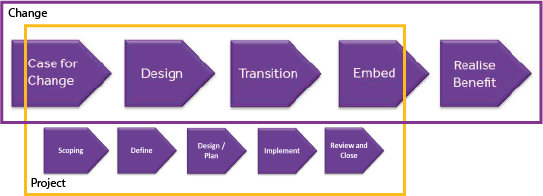What to we mean by delivering change?
From the initial concept of a change through to creating success and benefits, people can flounder on the deceptively simple question of ‘how do I do this?’
Providing a step-by-step process for change helps to take that anxiety away and following a best practice model ensures all steps are done, decisions and actions are taken, and the change is realised more quickly and effectively.
Introducing the change lifecycle

All change follows the same general path from the idea that change is required, through to the improvements making an impact.
Case for change
In practice...
There is an idea, a reason to change whether a problem or an opportunity, which needs to be communicated and understood to generate urgency to change. A project may be proposed to investigate and determine options on a way forward.
Design
In practice...
The future vision needs to be determined, clearly articulated and documented to establish what the new reality will look like.
Transition
In practice...
The specific actions to implement the vision need to be planned, agreed and performed to create the new reality.
Embed
In practice...
The new reality is monitored to ensure people continue to embrace the new way of working and do not recreate the old state. Any teething issues are tackled.
Realise benefit
In practice...
The new reality begins to create the expected benefits – this may be weeks, months or even years after the reality is implemented.
Change and project management
Typically change is delivered through a project. There are a lot of similarities but a project will close before the change lifecycle is finished.

